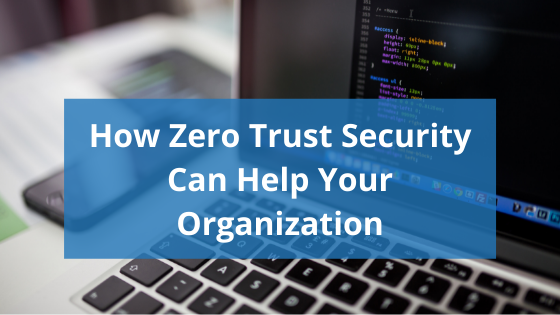Businesses of all sizes have seen an increase in sophisticated cyber-attacks which threaten data and finances. We have talked about the dangers of phishing attempts and the importance of continuous security training before, but some attackers are able to better hide their attempts to breach your security. Because of the continually evolving nature of cyber-attacks and following guidance from the Federal Government and leading IT Security experts, a Zero Trust security model could significantly reduce your vulnerability.
What is Zero Trust?
Common security practices and measures block known threats and are able to react once new threats have been introduced, but they are unable to prevent new threats from being introduced to your network entirely. Zero Trust security models, however, block any application or software from running unless it has been previously approved by your IT team. It also allows your IT team to control how applications can behave within your network, which helps prevent vulnerabilities in the tools you use from threatening your organization.
Zero Trust operates under some key principles:
- Explicit verification of user identity, location, device status, data classification, and anomalies
- The use of “least privileged” access, limiting user access with risk-based adaptive policies and data protection
- Minimizing potential impact by assuming a breach has occurred and verifying end to end encryption while using analytics to drive threat detection and improve defenses
What’s wrong with our current security?
Any approach to IT security is a valuable step and can help your organization decrease vulnerability, but tools like antivirus and firewalls rely on knowing what a threat or suspicious behavior looks like already. This means that malware could successfully disguise itself as a legitimate application and be allowed to run, wreaking havoc on your network. The time between a threat breaching your network and your IT team successfully eliminating it is critical, but a Zero Trust model operates under the assumption that everything is a threat and therefore extremely limited allowances are made. This prevents malware from running and allows you to retain peace of mind.
Let’s think about a normal day in your office. You’re preparing a presentation for a forthcoming Board meeting and need updated reports from staff and external partners which are sent to you as email attachments - spreadsheets, PDFs, etc. – that you save to your device to review and follow up on. At some point, you need help answering a question or solving a problem so you look it up and find a guide available for download. You send a draft of your Board presentation to your colleagues to review and follow up on areas where additional information is required.
At the end of the day, you sign out and return home. After a week goes by, you haven't noticed anything strange and you follow much of the same routine. Three months later you arrive to work and attempt to log in and look at your files, but they have been blocked. The only documents you can open contain a threat and a countdown clock, telling you that your files have been compromised and you now owe a ransom to get them back. You call your Operations Manager and several colleagues to find out that they have all experienced the same thing. While your IT team works to restore your files and clear the network of any lingering malware, you and your coworkers are faced with lots of stress. You need to contact people outside of the organization you have worked with to make sure they haven't been hit by the same ransomware, you lose hours or days to restoring your data, but much of it may still be missing, if things were particularly bad, you lost a large amount of money paying the ransom to the attackers. You later find out that your antivirus and firewall weren't able to prevent the attack, and that it most likely came from a regular seeming file somewhere on the network which spread throughout the entire organization. Nobody knew there was a problem before it was too late to prevent it, so traditional security measures didn't work.
The same situation would play out much differently if you had implemented a Zero Trust model. When you arrived at the office and began saving or downloading files in the course of your day, one of them may not have been able to open. The Zero Trust tools used by your IT team would have identified that the file was trying to act in a malicious way and prevented it from doing so, keeping your organization’s network secure. This is because any file or tool trying to run differently than previously allowed would be considered a threat and shut down. Instead of the malware being allowed to access more and more parts of your network over the course of a few weeks, it would be stopped at the beginning, saving you time, stress, and money.
How would this impact my team?
Implementing a Zero Trust model does not happen overnight. First, your IT team will need to review your environment and user behavior to identify the tools you need for day-to-day operations and allow them to run appropriately. This will prevent a lot of user-related stress when making this change to your security model. However, if a user tried to download or run an application that wasn’t allowed, like using a photo editing tool when your organization has not pre-approved it, the application would not be allowed to run. This helps prevent the use of unpermitted software and helps defend against malware that may look like a legitimate application. Your IT team will be able to review and approve new software tools as your needs grow or change.
In an increasingly technology-dependent world and with the constant evolution of cyber-attacks, older security models may be too vulnerable to rely on. By enforcing higher protection standards, you substantially reduce your organization’s risk, leaving you free to worry about other things. Increased security is always critical and turning to the Zero Trust model can help. If you are interested in Zero Trust or want to talk about your IT security measures, please contact us.





Leave a Reply